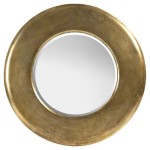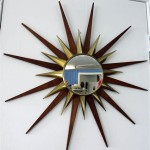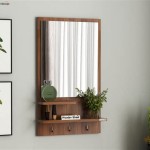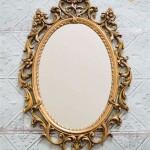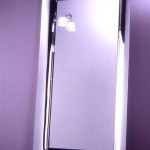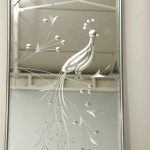Can You Hang a Heavy Mirror on Drywall?
Hanging a heavy mirror on drywall can be a challenging task, but with the proper techniques and hardware, it can be accomplished safely and securely. The weight of the mirror, the type of drywall, and the wall framing all play crucial roles in determining the best hanging method.
Standard drywall, typically 1/2-inch thick, can support a surprising amount of weight, but the key is distributing that weight effectively. Simply driving a nail or screw directly into drywall will not provide adequate support for heavier mirrors, as the fastener will likely pull out under the weight. The goal is to anchor the mirror into the wall studs, the vertical framing members that provide structural support to the wall.
Locating the wall studs is the first crucial step. A stud finder, an electronic device readily available at most hardware stores, is the most efficient method. Sliding the stud finder across the wall will indicate the location of the studs beneath the drywall. Alternatively, gentle tapping on the wall can sometimes help identify studs, as a solid thud will indicate a stud, while a hollow sound indicates the space between studs.
Once the studs are located, the appropriate hanging hardware can be selected. For heavier mirrors, it's recommended to use heavy-duty picture hangers rated for the mirror's weight. These hangers often have multiple small nails or screws that distribute the weight across a wider area of the stud. Toggle bolts are another excellent option, especially when dealing with particularly heavy mirrors. Toggle bolts work by expanding behind the drywall, creating a strong anchor point. They are inserted through a drilled hole in the drywall and then tightened, pulling the toggle against the back of the drywall for a secure hold.
D-rings and wire are a common hanging method for framed mirrors. However, for heavier mirrors, using two D-rings and two separate wires is recommended, providing extra stability and distributing the weight more evenly. When using D-rings and wire, ensure the wire is rated to hold the weight of the mirror. The wire should be wrapped tightly around the D-rings and secured with wire clamps.
French cleats offer an alternative hanging system, particularly suitable for heavy and oversized mirrors. A French cleat consists of two interlocking pieces of wood, one attached to the back of the mirror and the other attached to the wall studs. The angled design of the cleat provides a strong and secure grip. This method is especially useful for very large mirrors, as it distributes weight across a larger surface area.
In situations where locating a stud is not feasible or where extra support is desired, specialized drywall anchors designed for heavy objects can be used. These anchors are specifically engineered to provide a strong hold in drywall without requiring access to a stud. Examples include molly bolts and self-drilling anchors. It's crucial to choose anchors rated for the weight of the mirror and follow the manufacturer's instructions carefully for proper installation.
The weight of the mirror is a primary factor in determining the appropriate hanging method. For lighter mirrors, simple picture hangers may suffice. However, for heavier mirrors exceeding 20 pounds, heavier-duty hangers, toggle bolts, French cleats, or specialized drywall anchors are recommended. Always consult the weight rating of the chosen hanging hardware to ensure it can support the mirror's weight.
Drywall thickness also plays a role. While standard 1/2-inch drywall is common, thicker drywall, such as 5/8-inch, provides greater inherent strength and can support more weight. If hanging a particularly heavy mirror, consider the drywall thickness and choose appropriate hardware accordingly.
Before hanging a heavy mirror, carefully inspect the wall for any damage or weaknesses. If there are cracks or significant damage to the drywall, it's essential to repair these areas before attempting to hang the mirror. Attempting to hang a heavy mirror on damaged drywall can lead to the mirror falling and causing injury or further damage.
Accurate measurements are essential for successful installation. Carefully measure the mirror's dimensions and mark the desired location on the wall. Use a level to ensure the markings are straight and even. Accurate measurements will help prevent the mirror from hanging crookedly.
Safety should always be a primary concern when hanging heavy objects. Wearing appropriate safety gear, such as safety glasses and gloves, is recommended. If the mirror is particularly large or heavy, enlisting the help of another person is advisable to avoid injury and ensure proper installation.
By following these guidelines and selecting the appropriate hardware for the mirror's weight and the wall's construction, hanging a heavy mirror on drywall can be a straightforward and safe process. Careful planning and execution will result in a securely hung mirror that enhances any room.

How To Hang A Heavy Mirror On Drywall Stas Picture Hanging Systems

How To Hang A Heavy Mirror With French Cleat

How To Hang A Large Or Heavy Mirror

How To Hang A Very Heavy Picture Or Mirror The Best

How To Hang A Heavy Mirror Diy Family Handyman

How To Hang A Heavy Mirror

How To Hang A Heavy Mirror

How To Hang A Heavy Mirror C R F T
:strip_icc()/ScreenShot2022-04-28at1.12.19PM-e055476c70c6438585fa7c5cd531edcf.png?strip=all)
4 Easy Ways To Hang A Heavy Mirror

How To Hang A Heavy Mirror Or Picture True Value

